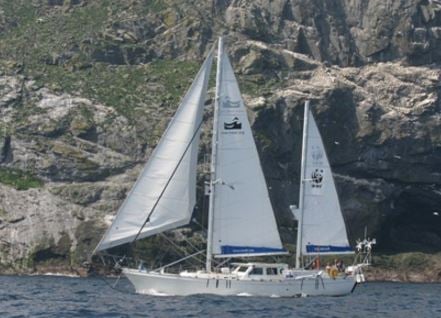Record sightings of juveniles off Scotland’s west coast may be due to a minke whale baby boom, says the Hebridean Whale and Dolphin Trust. Marine research expeditions carried out by the Trust recorded more sightings this season than ever before.
The Trust says there are two possible reasons for the increase: 1. Many more mink whale calves (babies) have been born. 2. There has been an influx of minke whales (Balaenoptera acutorostrata) from somewhere.
A record number of common dolphin sightings was also recorded by the charity during the 2015 research season – 723 individual dolphins were observed over 63 encounters.
 Are minke whales breeding more, or are the record sightings due to something else? (Image: wildwhales.org)
Are minke whales breeding more, or are the record sightings due to something else? (Image: wildwhales.org)
Once, the common dolphin was uncommon in the Hebrides. Over the past 12 years, the Trust’s encounter rate with the species has increased by more than 100%. Nobody is sure why.
Monitoring cetaceans must continue
Hebridean Whale and Dolphin Trust Biodiversity Officer, Kerry Froud, said:
“These intriguing changes in Scotland’s marine life highlight the importance of long-term monitoring of *cetaceans – so that we can better understand what is happening in our waters, and then make management recommendations to better protect this world-class area of marine biodiversity.”
*Cetaceans are fully-aquatic marine mammals such as the dolphin, porpoise or whale.
Scientists and volunteers carried out studies in the area between May and October on board Silurian, the Trust’s dedicated research yacht.
The research forms part of the Trust’s long-term monitoring of cetaceans in the Hebrides. During their surveys they also gather data on basking sharks.
Encounters with minke whale juveniles have been steadily increasing since 2011, and rose sharply in 2015.
The scientists documented an encounter rate of 1 young minke whale per 286 km – triple the average over the Trust’s entire dataset.
 Silurian – the yacht used by researchers to look for whales and dolphins. (Image: whaledolphintrust.co.uk)
Silurian – the yacht used by researchers to look for whales and dolphins. (Image: whaledolphintrust.co.uk)
The minke whale
The minke whale, also called the Lesser Rorqual, is the smallest of all baleen whales. Baleen whales use baleen plates, and not teeth, to feed. They feed in the North Atlantic, and measure up to 10 meters in length.
Minke whales are the most commonly observed baleen whales off the UK coast.
The Trust has an identification catalogue of 125 different minke whales that are known to have visited the Hebrides. Some of them return to the same spot each year, while others appeared to be passing through.
While the increasing encounter rate of young minke whales is good news, there are still several serious issues regarding the conservation of this migratory animal.
 Common dolphin sightings have also increased considerably. (Image: www.whaledolphintrust.co.uk)
Common dolphin sightings have also increased considerably. (Image: www.whaledolphintrust.co.uk)
Mink whales hunted further north
Norway and Iceland, which are not far from Scotland, still hunt minke whales. The Trust’s scientists do not know whether the mink whales that swim through Scottish waters frequent areas where they risk being hunted.
The unprecedented number of common dolphin sightings, plus the sighting of the species off Tromso in Norway in September, the most northerly sighting ever, suggests that changes are underway within our oceans and seas.
The causes and wider effects on marine life and their environment are still unclear, the Trust emphasizes. This underlies the importance of on-going research.
Hebridean Whale and Dolphin Trust wrote on its website:
“Alongside warming seas and climate change, human activities causing increasing stress on cetaceans and basking sharks include fisheries by-catch, pollution, underwater noise and habitat loss.”
“Cetacean entanglement in litter and fishing gear can cause mobility problems, injury and even death, and the trust is working cooperatively with the fishing industry and other researchers in the UK to better understand this problem so that it can be addressed. This year, ironically whilst the Silurian crew was celebrating a volunteer’s 60th birthday, a bunch of balloons was retrieved from the water – a reminder that celebratory balloons, even if marketed as ‘biodegradable’, can have lasting consequences for our wider environment.”
Video – Meet minke whales
